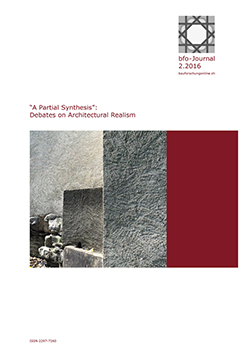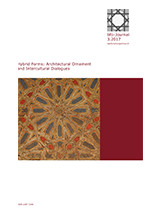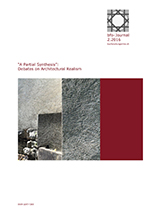
bfo-Journal 2.2016
“A Partial Synthesis”: Debates on Architectural Realism
Download complete volume
Editorial
Irina DavidoviciDownload PDF
Realism and Rationalism: An Italian-German Architectural Discourse
Silvia Malcovati
In Search of Socialist Truthfulness: Debates on Realism in Soviet Architecture 1930-1950
Maria Silina
Auf der Suche nach Klarheit. Zum Realismus im Werk des Schweizer Architekten Hans Schmidt
Kathrin Siebert
Immagini della forma. Il realismo di Asnago e Vender tra pittura e architettura
Giulio Bettini
A Magic-Real Gap in Architecture
Carolina Dayer
bfo-Journal 2.2016
Abstracts
Realism and Rationalism: An Italian-German Architectural Discourse
Silvia Malcovati
Politecnico di Torino
Looking backwards from the recent philosophical debate on new rea-lism, this paper examines the relationship between realism and rationa-lism in the history of modern and postwar architecture, focusing on the Italian-German relationship. The discourse is characterised as a dialectical relationship between the two notions and between two architectural cultures, finding its peculiar expression in a complex intertwining of mutual references and interpretations. While Italian modern architecture shows a strong dependence on German rationalism until the postwar period, conversely, the Italian architectural theories of the last fifty years have significantly influenced the thinking of German architects and are reflected in the reality of their buildings.
In Search of Socialist Truthfulness: Debates on Realism in Soviet Architecture 1930-1950
Maria Silina
Université du Québec à Montréal
This paper outlines how the architectural theories elaborated by critics such as Moisei Ginsburg and Alexander Gabrichevkii were reshaped after the 1930s, when the notion of socialist realism was introduced into the domain of Soviet arts. In the 1920s, Soviet historians shared with European colleagues a view of architecture as the evolution of mass and space, widely used to prescribe a formalist agenda. When it came to the socialist realism doctrine, critics altered their research methods, previously based on idealist terminology, to issue deterministic formulas of style development. This transformation enables the examination of the mechanism of (self-)censorship that led to the graduate degradation of professional architectural criticism in the Soviet Union.
Auf der Suche nach Klarheit. Zum Realismus im Werk des Schweizer Architekten Hans Schmidt
Kathrin Siebert
ETH Zürich
Der Basler Architekt Hans Schmidt (1893-1972) zog 1930 nach Moskau, um an der staatlichen Architektur- und Stadtplanung mitzuwirken. Zu Beginn der 1930er Jahre manifestierte sich der sowjetische Architekturdiskurs, der Sozialistische Realismus wurde zur Staatsdoktrin. Schmidt, als massgebender Vertreter des Neuen Bauens in der Schweiz in den 1920er Jahren, setzte sich kritisch mit dem progressiven und dem traditionellen Denken auseinander und entwickelte eine eigene Haltung zum Realismus.
Immagini della forma. Il realismo di Asnago e Vender tra pittura e architettura
Giulio Bettini
L'articolo rintraccia le origini degli elementi impiegati da Mario Asnago e Claudio Vender nelle loro ammirate composizioni architettoniche, approfondendone la metodologia di elaborazione. L'operato pittorico dei due architetti si rivela in questo ambito come fondamentale, permettendogli di realizzare opere dal carattere realista senza palesarne banalmente i modelli. Elementi e metodi non distanti dal fare architettura contemporaneo, per cui Asnago e Vender restano protagonisti di riferimento.
A Magic-Real Gap in Architecture
Carolina Dayer
Aarhus School of Architecture
In 1925, German art critic Franz Roh formalized the notion of Magic Realism (magischer Realismus) as a celebration of everyday life. In Italian literature, the same notion was explored in the works of Massimo Bontempelli. But it was the architect Friedrich Kiesler who imported the notion into architecture, stating that 'Magic Architecture ... holds the balance between the two extremes of man', his 'desire for the machine' and technology on the one hand, his 'denial of science' on the other. This paper follows the development of the notion of Magic Realism throughout the twentieth century and into the twenty-first, tracing its re-emergence in works as varied as those of Carlo Scarpa, Billie Tsien and Tod Williams.





